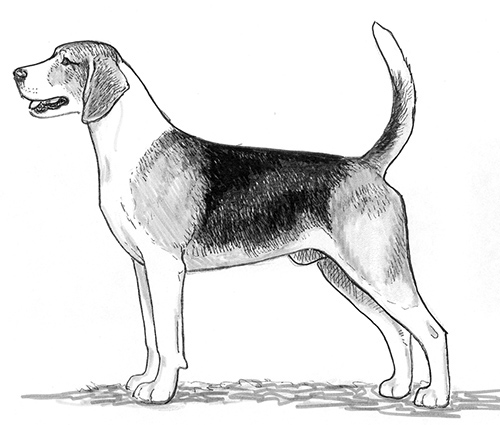English Foxhound
Scenthound Group
The goals and purposes of this breed standard include: to furnish guidelines for breeders who wish to maintain the quality of their breed and to improve it; to advance this breed to a state of similarity throughout the world; and to act as a guide for judges.
Breeders and judges have the responsibility to avoid any conditions or exaggerations that are detrimental to the health, welfare, essence and soundness of this breed, and must take the responsibility to see that these are not perpetuated.
Any departure from the following should be considered a fault, and the seriousness with which the fault should be regarded should be in exact proportion to its degree and its effect upon the health and welfare of the dog and on the dog’s ability to perform its traditional work.
History
The English Foxhound was developed in Great Britain in the 13th century expressly for the purpose of trailing the red fox during a mounted hunt. Breeds which were used in this process include the St. Hubert/Bloodhound types, with crosses made to swifter, lighter hounds, which may have included the Greyhound. The breeding of Foxhounds has always been, and continues to be, in the hands of the Masters of Foxhounds. There have been over two hundred and fifty packs of Foxhounds in Great Britain.
The English Foxhound was recognized by the United Kennel Club in 1905.
General Appearance
The breed is well balanced, powerful and clean cut.
Characteristics
Full of stamina and the capacity for endurance, the English Foxhound has a natural ability to hunt and is friendly and not aggressive.
Head
SKULL
The skull is flat and of medium width. The stop is slight.
MUZZLE
The muzzle is long and square. The flews are moderately developed.
TEETH
A full complement of strong, white teeth meet in a scissors bite.
Disqualifications: Undershot or overshot bite.
NOSE
Nostrils are open.
EARS
The leathers are pendant, close to the head and set high.
Neck
The neck is long, slightly arched and well developed without being coarse.
Forequarters
The long, well-sloped shoulders are well clothed with muscle, especially at the points, without being heavy.
FORELEGS
The forearm is long and muscular, but free from fat or lumber. The well-let-down elbows are set quite straight, and turn neither in nor out. The forelegs are long, straight and well boned down to the feet. The pasterns are strong.
Body
The chest is deep and the ribs are well sprung. The back is broad and level and there is a slight rise over the strong loin.
Hindquarters
The hindquarters are powerful and muscular.
HIND LEGS
The hind legs are well boned down to the feet. There is moderate turn of stifle. The hocks are well let down.
Feet
Round, tight, strong and well padded.
Tail
Well set on high, carried gaily but never curled over the back.
Coat
The coat is short, dense and weatherproof.
Color
Any good hound color is acceptable.
Gait
Free striding and tireless, with the ability to gallop. Strong drive from behind with no tendency to roll.
Size
Approximately 23 to 25 inches at the shoulder.
Disqualifications
(A dog with a Disqualification must not be considered for placement in a conformation event, and must be reported to UKC.)
Unilateral or bilateral cryptorchid.
Viciousness or extreme shyness.
Undershot or overshot bite.
Albinism.

Looking for a Dog?
Find a dog that will fit your family.
Note: The breeders on this list are not endorsed by UKC.
Revised January 1, 2009
©Copyright 1992, United Kennel Club
